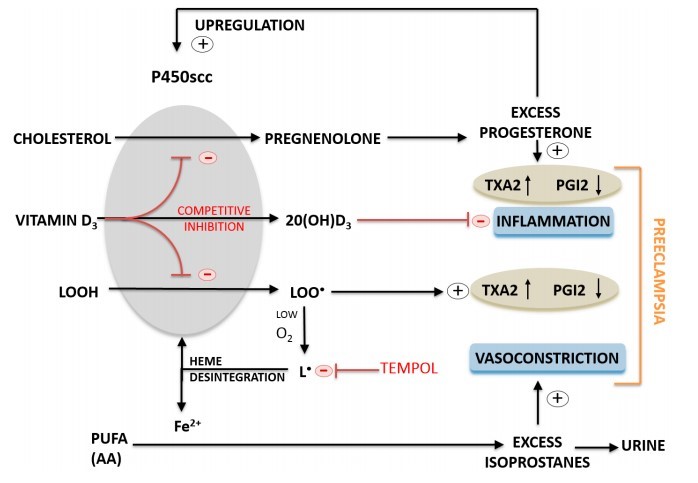Preeclampsia – hypothesis as to why vitamin D helps
A Proposed Molecular Mechanism of High-Dose Vitamin D3 Supplementation in Prevention and Treatment of Preeclampsia
Int. J. Mol. Sci. 2015, 16(6), 13043-13064; doi:10.3390/ijms160613043 (registering DOI)
Piotr Zabul 1,* , Michal Wozniak 2, Andrzej T. Slominski 3, Krzysztof Preis 4, Magdalena Gorska 2, Marek Korozan 1, Jan Wieruszewski 2, Michal A. Zmijewski 5, Ewa Zabul 6, Robert Tuckey 7, Alicja Kuban-Jankowska 2, Wieslawa Mickiewicz 2 and Narcyz Knap 2,*
1 Department of Obstetrics & Gynecology, the Sw. Wojciech Specialist Hospital, Independent Public Complex of Integrated Health Care Units in Gdansk, 50 Al. Jana Pawła II St., Gdansk 80-462, Poland
2 Department of Medical Chemistry, Medical University of Gdansk, 1 Debinki St., Gdansk 80-211, Poland
3 Department of Dermatology, University of Alabama at Birmingham, VA Medical Center, Birmingham, AL 35294, USA
4 Department of Obstetrics & Gynecology, Medical University of Gdansk, 1A Kliniczna St., Gdansk 80-402, Poland
5 Department of Histology, Medical University of Gdansk, 1 Debinki St., Gdansk 80-211, Poland
6 Department of Anesthesiology & Intensive Care, Medical University of Gdansk, 1 Debinki St., Gdansk 80-211, Poland
7 School of Chemistry and Biochemistry, the University of Western Australia, 35 Stirling Highway, Crawley, WA 6009, Australia
- Authors to whom correspondence should be addressed.
Received: 12 February 2015 / Revised: 31 May 2015 / Accepted: 1 June 2015 / Published: 9 June 2015
(This article belongs to the Section Biochemistry, Molecular Biology and Biophysics)

A randomized prospective clinical study performed on a group of 74 pregnant women (43 presenting with severe preeclampsia) proved that urinary levels of 15-F2t-isoprostane were significantly higher in preeclamptic patients relative to the control (3.05 vs. 2.00 ng/mg creatinine). Surprisingly enough, plasma levels of 25-hydroxyvitamin D3 in both study groups were below the clinical reference range with no significant difference between the groups. In vitro study performed on isolated placental mitochondria and placental cell line showed that suicidal self-oxidation of cytochrome P450scc may lead to structural disintegration of heme, potentially contributing to enhancement of oxidative stress phenomena in the course of preeclampsia. As placental cytochrome P450scc pleiotropic activity is implicated in the metabolism of free radical mediated arachidonic acid derivatives as well as multiple Vitamin D3 hydroxylations and progesterone synthesis, we propose that Vitamin D3 might act as a competitive inhibitor of placental cytochrome P450scc preventing the production of lipid peroxides or excess progesterone synthesis, both of which may contribute to the etiopathogenesis of preeclampsia. The proposed molecular mechanism is in accord with the preliminary clinical observations on the surprisingly high efficacy of high-dose Vitamin D3 supplementation in prevention and treatment of preeclampsia.
📄 Download the PDF from VitaminDWiki
See also VitaminDWiki
Risk of preeclampsia might be cut in half if take an amount of Vitamin D – meta-analysis Sept 2017
Preeclampsia was prevented or treated by vitamin D in majority of studies – review May 2015
Preeclampsia inversely proportional to serum Magnesium – Oct 2014
Dark-skined mothers: preeclampsia 12X more likely if gestational hypertension – May 2014
2X more preeclampsia when vitamin D less than 30 ng, etc. - meta-analysis March 2013
Why preeclampsia is 5X more likely if vitamin D insufficient – Jan 2015
